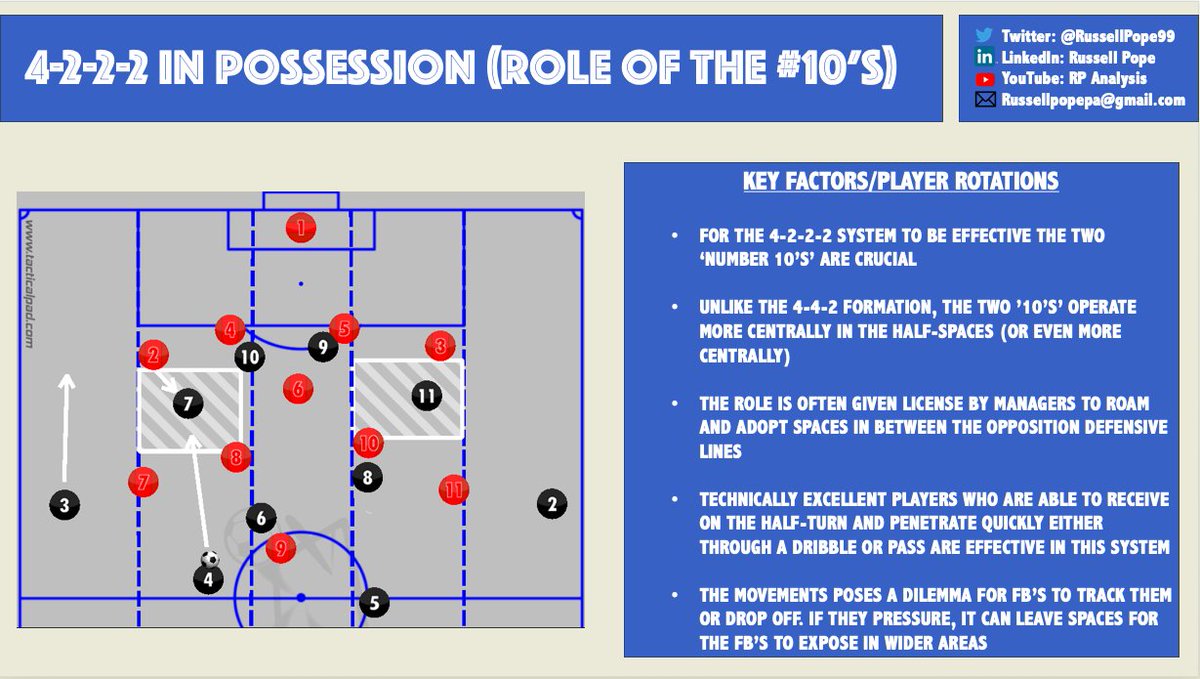
THE WORKINGS OF THE 4-2-2-2: A THREAD👇
🔵 High-Block Pressing
🔵 Building in the 1st phase
🔵 Role of the #10's
@TacticalPad
RT's appreciated!
More threads like this to come...
🔵 High-Block Pressing
🔵 Building in the 1st phase
🔵 Role of the #10's
@TacticalPad
RT's appreciated!
More threads like this to come...

Natural Strengths and Weaknesses of the 4-2-2-2 system👇
A system utilised by teams such as; Southampton, PSV Eindhoven and Red Bull Salzburg.
#SaintsFC #PSV #RBSalzburg
A system utilised by teams such as; Southampton, PSV Eindhoven and Red Bull Salzburg.
#SaintsFC #PSV #RBSalzburg

In Possession: 4-2-2-2 with the 'Number 10's inverting more centrally into the Half-Spaces (Creating central overloads)
Out of Possession: Reverting to a more standard 4-4-2 formation with the 'Number 10's' shifting wider to track the outside channels
Out of Possession: Reverting to a more standard 4-4-2 formation with the 'Number 10's' shifting wider to track the outside channels

4-2-2-2 Defending in a High-Block (Pressing Structure)
🔵 Pressure on 1st Pass
🔵 Man-oriented structure
🔵 CF dropping deeper to solve 3v2 midfield superiority
🔵 Pressure on 1st Pass
🔵 Man-oriented structure
🔵 CF dropping deeper to solve 3v2 midfield superiority

Mid-Block (Delay, Deny, Deflect Principles)
🔵 Reverts to a more standard 4-4-2
🔵 Narrow structure to deflect play around the block
🔵 Wider channels present a 2v2 match up
🔵 Reverts to a more standard 4-4-2
🔵 Narrow structure to deflect play around the block
🔵 Wider channels present a 2v2 match up

Low-Block (Compactness and Pressing Triggers)
🔵 Maintaining central compactness (Using natural shape to force play wider)
🔵 Central channels zonally marked (Centre, Left/Right Half-Spaces covered)
🔵 Pressing trigger is the ball into FB/Winger (Using touchline as a defender)
🔵 Maintaining central compactness (Using natural shape to force play wider)
🔵 Central channels zonally marked (Centre, Left/Right Half-Spaces covered)
🔵 Pressing trigger is the ball into FB/Winger (Using touchline as a defender)

4-2-2-2 In Possession (Building from the GK)
🔵 Diamond structure (GK, CB's and the Six)
🔵 11 & 7 inverting centrally with CF dropping deeper
🔵 Aims to create central overloads whilst freeing space in wider areas
🔵 Diamond structure (GK, CB's and the Six)
🔵 11 & 7 inverting centrally with CF dropping deeper
🔵 Aims to create central overloads whilst freeing space in wider areas

CM Rotations (3v2 central underload)
🔵Outside/Inbetween rotations to receive from CB's
🔵 Aims to receive outside opposition block
🔵 Allows the team to build initially with three players (Frees up space for other players to receive)
🔵Outside/Inbetween rotations to receive from CB's
🔵 Aims to receive outside opposition block
🔵 Allows the team to build initially with three players (Frees up space for other players to receive)

The role of the #10's
🔵Operate in between the oppositions defensive lines
🔵Technically proficient to receive on the half-turn
🔵 Freeing up space in the wide channel for the FB's
🔵Operate in between the oppositions defensive lines
🔵Technically proficient to receive on the half-turn
🔵 Freeing up space in the wide channel for the FB's

• • •
Missing some Tweet in this thread? You can try to
force a refresh















